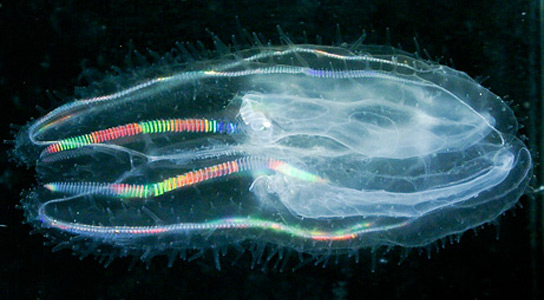
Tasmanian Comb Jelly
Genome-sequencing data indicates that sponges were preceded by ctenophores, complex marine predators also called comb jellies.
The scientists presented their findings at the annual meeting for the Society for Integrative and Comparative Biology, in San Francisco, California.
Although they are gelatinous like jellyfish, comb jellies form their own phylum (ctenophores.) The tree of life roots the comb jellies’ lineage between the group containing jellyfish and sea anemones and the one containing animals with heads and rears, which includes slugs, flies, and humans. Ctenophores swim through the sea with iridescent cilia, and snare prey with sticky tentacles. They have nerves, muscles, tissue layers, and light sensors, all of which sponges lack.
Developmental biologists from the University of Washington in Seattle sequenced the genome of the comb jelly Pleurobrachia bachei and they discovered that DNA sequences place them at the base of the animal tree of life. Another team presented results from the genome sequencing of the comb jelly Mnemiopsis leidyi and found that the phylum lands below or as close to the base as sponges on the tree of life.
It’s been thought that predator-prey interactions as well as sensory adaptations evolved long after the origin of sponges, states Billie Swalla, part of the University Washington team. The ancestor of all animals might look different from modern comb jellies and sponges.
Gene families, cell-signaling networks, and patterns of gene expression in comb jellies support the ancient origin. Ctenophores grow their nerves with unique sets of genes. It’s possible that they are descendants of Ediacaran organisms, which appeared in the fossil record before animals.
Comb jellies are the only animals that lack certain genes crucial to producing microRNA, states Andy Baxevanis, a comparative biologist at the US National Human Genome Research Institute in Bethesda, Maryland, and leader of the M. leidyi project. These short RNA chains help regulate gene expression. Sponges and comb jellies lack other gene families that all other animals possess.
If ctenophores evolved before sponges, the sponges probably lost some of their ancestors’ complexity. It’s also possible that sponges have a complexity that has yet to be defined.
Reference: “Genome reveals comb jellies’ ancient origin” by Amy Maxmen, 8 January 2013, Nature.
DOI: 10.1038/nature.2013.12176


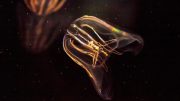


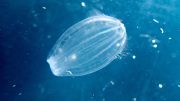

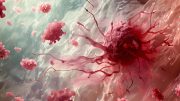
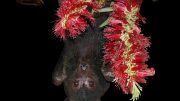
Be the first to comment on "Sequencing of Comb Jellies’ DNA Reveals That They Preceded Sponges"